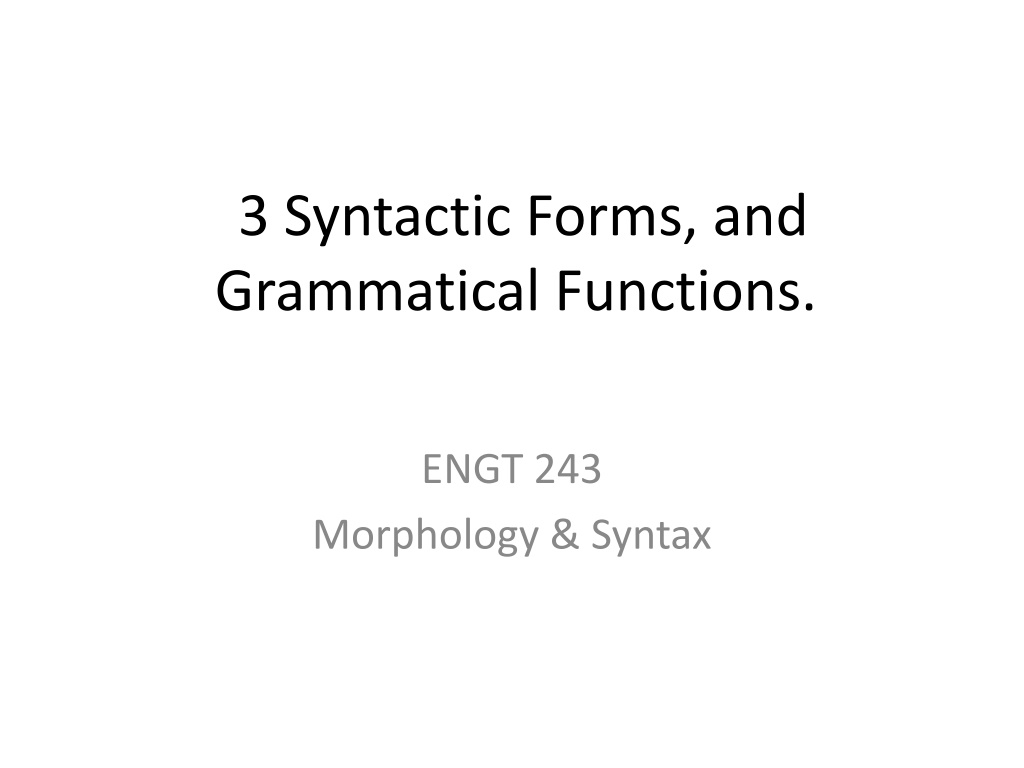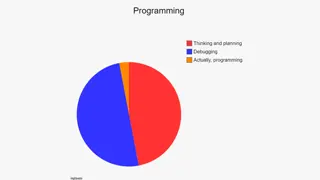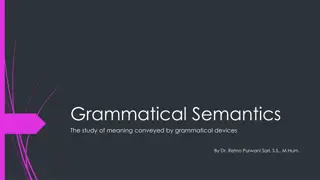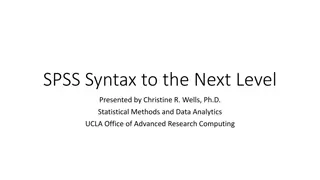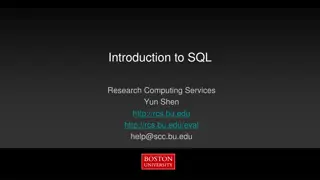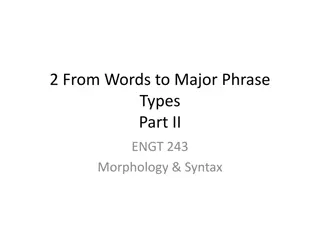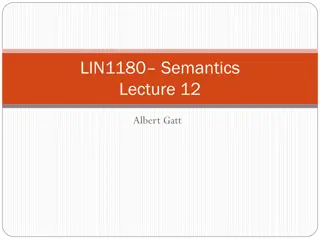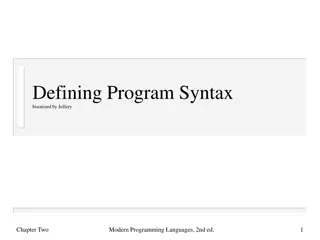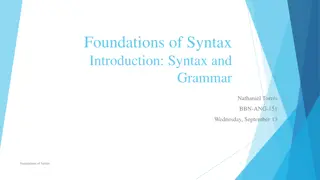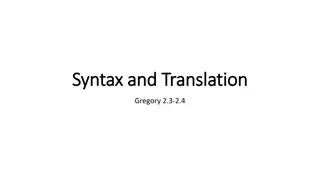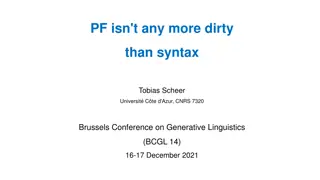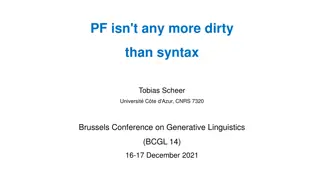Understanding Grammatical Functions in Syntax
The study of syntactic forms and grammatical functions is crucial in analyzing sentence structures. This includes identifying subjects, objects, modifiers, and predicates. Various tests can be employed to determine grammatical functions, such as agreement, tag questions, and subject-auxiliary inversion. Semantic roles like agent and patient can also provide insights into sentence structures.
Download Presentation

Please find below an Image/Link to download the presentation.
The content on the website is provided AS IS for your information and personal use only. It may not be sold, licensed, or shared on other websites without obtaining consent from the author. Download presentation by click this link. If you encounter any issues during the download, it is possible that the publisher has removed the file from their server.
E N D
Presentation Transcript
3 Syntactic Forms, and Grammatical Functions. ENGT 243 Morphology & Syntax
The PS rule S NP VP The basic rule for forming well-formed English sentences. It represents the constituent structure of a given sentence in terms of lexical and phrasal syntactic categories.
There are other dimensions of the analysis of sentences; One such way is using the notion of grammatical functions such as subject and object: (1) a. Syntactic categories: N, A, V, P, NP, VP, AP, . . . b. Grammatical functions: SUBJ (Subject), OBJ (Object), MOD (Modifier), PRED (Predicate), . . .
(2) The monkey kicked a boy on Monday. a. syntactic categories b. [S [NP The monkey] [VP kicked [NP a boy] [PP on Monday]]]. b. grammatical functions b. [S [SUBJ The monkey] [PRED kicked [OBJ a boy] [MOD on Monday]]].
We also can represent sentence structure in terms of semantic roles. Constituents can be considered in terms of conceptual notions of semantic roles such as agent, patient, location, instrument, and the like.
3.2 Grammatical Functions How can we identify the grammatical function of a given constituent? Several tests can be used to determine grammatical function
3.2.1 Subjects Consider the following pair of examples: (6) a. [The cat] [devoured [the rat]]. b. [The rat] [devoured [the cat]]. These two sentences have exactly the same words and have the same predicator devoured. BUT they are significantly different in meaning. the main difference comes from what serves as subject or object with respect to the predicator. The subject is the cat (6a) it is the rat (6b) The object is the rat in (6a) but the cat in (6b).
3.2.1 Subjects More reliable tests for subjecthood come from syntactic tests such as - Agreement - tag questions - subject-auxiliary inversion.
3.2.1 Subjects Agreement: The main verb of a sentence agrees with the subject in English: (8) a. She never writes/*write home. b. These books *saddens/sadden me. c. Our neighbor takes/*take his children to school in his car.
3.2.1 Subjects Agreement: Being closer to the main verb does not entail subjecthood: (9) a. The book, including all the chapters in the first section, is/*are very interesting. b. The effectiveness of teaching and learning *depend/depends on several factors. c. The tornadoes that tear through this county every spring *is/are more than just a nuisance.
3.2.1 Subjects Tag questions: A tag question, a short question tagged onto the end of an utterance, is also a reliable subjecthood test: (10) a. The lady singing with a boy is a genius, isn t she/*isn t he? b. With their teacher, the kids have arrived safely, haven t they/ *hasn t he?
3.2.1 Subjects Subject-auxiliary inversion: In forming questions and other sentence-types, English has subject-auxiliary inversion, which applies only to the subject. (11) a. This teacher is a genius. b. The kids have arrived safely. c. It could be more detrimental. (12) a. Is this teacher a genius? b. Have the kids arrived safely? c. Could it be more detrimental?
3.2.2 Direct and Indirect Objects A direct object (DO) is canonically an NP, undergoing the process denoted by the verb: (14) a. His girlfriend bought this computer. b. That silly fool broke the teapot. However, this is not a solid generalization.
3.2.2 Direct and Indirect Objects Once again, the data show us that we can NOT identify the object based on semantic roles. A much more firm criterion is the syntactic construction of passivization, in which a notional direct object appears as subject.
3.2.2 Direct and Indirect Objects (16) a. His girlfriend bought this computer for him. b. The child broke the teapot by accident. (17) a. This computer was bought for him by his girlfriend. b. The teapot was broken by the child by accident. What we can notice here is that the objects in (16) are promoted to subject in the passive sentences.
3.2.2 Direct and Indirect Objects The test comes from the fact that non-object NPs can NOT be promoted to the subject: (18) a. This item belongs to the student. b. *The student is belonged to by this item. (19) a. He remained a good friend to me. b. *A good friend is remained to me (by him).
3.2.2 Direct and Indirect Objects The objects that undergo passivization are direct objects, distinct from indirect objects. An indirect object (IO) is a. one which precedes a direct object (DO), as in (20); b. has the semantic roles of goal, recipient, or benefactive: (20) a. I threw [the puppy] [the ball]. (IO = goal) b. John gave [the boys] [the CDs]. (IO = recipient) c. My mother baked [me] [a birthday cake]. (IO = benefactive)
3.2.2 Direct and Indirect Objects b. John gave [the boys] [the CDs]. A caution is in order when a DO follows an IO as in (20), the DO cannot be passivized: (21) a. *The CDs were given the boys by John.
3.2.2 Direct and Indirect Objects b. John gave [the boys] [the CDs]. In examples like (20), passive has the property of making the IO into the subject. (22) a. The boys were given the CDs (by John).
3.2.2 Direct and Indirect Objects Note that sentences with the IO-DO order are different from those where the semantic role of the IO is expressed as an oblique PP, following the DO: (23) a. John gave the CDs to the boys. b. The publisher sent a review copy of the book to her. c. My mother baked a cake for me. In this kind of example, it is once again the DO which can be passivized, giving examples like the following: (24) a. The CDs were given to the boys by John. b. A review copy of the book was sent to her by the publisher. c. This cake was baked for me by my mother.
3.2.3 Predicative Complements There also are NPs which follow a verb but which do not behave as DOs or IOs. Consider the following sentences: (25) a. This is my ultimate goal. b. Michelle became an architect. (26) a. They elected Graham chairman. b. I consider Andrew the best writer. The italicized elements here are traditionally called predicative complements in the sense that they function as the predicate of the subject or the object.
3.2.3 Predicative Complements Even though they are NPs, they do not passivize (27) a. *Chairman was elected Graham. b. *The best writer was considered Andrew.
3.2.3 Predicative Complements The difference between objects and predicative complements can also be seen in the following contrast: (28) a. John made Kim a great doll. b. John made Kim a great doctor. Even though the italicized expressions here are both NPs, they function differently. The NP a great doll in (28a) is the direct object, as in John made a great doll for Kim, Th NP a great doctor in (28b) cannot be an object: it serves as the predicate of the object Kim.
3.2.3 Predicative Complements If we think of part of the meaning informally, only in the second example would we say that the final NP describes the NP Kim. (29) a. (28)a: Kim = a great doll b. (28)b: Kim = a great doctor .
3.2.4 Oblique Complements Consider now the italicized expressions in (32): (32) a. John put books in the box. b. John talked to Bill about the exam. c. They would inform Mary of any success they have made. These italicized expressions are neither objects nor predicative complements. Since their presence is obligatory, for syntactic well- formedness, they are called oblique complements. Oblique phrases are typically expressed as PPs in English.
3.2.4 Oblique Complements As we have seen before, most ditransitive verbs can also take oblique complements: (33) a. John gave a book to the student. b. John bought a book for the student. c. John asked Bill of a question. - The PPs here, which cannot be objects since they are not NPs - also do not serve as predicate of the subject or object - they relate directly to the verb, as oblique complements.
Complements COMPS The functions of DO, IO, predicative Complement, and oblique complement all have one common property: They are all selected by the verb to complement the verb & form a legitimate VP. Hence, these are called complements (COMPS), and typically they cannot be omitted.
3.2.5 Modifiers Unlike these COMPS, - there are expressions which do not complement the predicate in the same way, - and which are truly optional: (34) a. The bus stopped suddenly. b. Shakespeare wrote his plays a long time ago. c. They went to the theater in London. d. He failed chemistry because he can t understand it. The italicized expressions here are all optional and function as modifiers (also called adjuncts or adverbial expressions).
3.2.5 Modifiers These modifiers specify - the manner - Location - Time - or reason they are the (how, when, where, and why) phrases.
3.2.5 Modifiers One additional characteristic of modifiers is that they can be stacked up, whereas complements cannot. (35) a. *John gave Tom [a book] [a record]. b. I saw this film [several times] [last year] [during the summer]. As shown here, temporal adjuncts like several times and last year can be repeated, whereas the two complements a book and a record in (35a) cannot.
3.2.5 Modifiers Of course, temporal adjuncts do not become the subject of a passive sentence, suggesting that they cannot serve as objects. (36) a. My uncle visited today. b. *Today was visited by my uncle.
3.3 Form and Function Together We now can analyze each sentence in terms of grammatical functions as well as the structural constituents.
Different phrase types can function as SUBJ (39) a. [NP The termites] destroyed the sand castle. b. [VP Being honest] is not an easy task. c. [CP That John passed] surprised her. d. [VP To finish this work on time] is almost unexpected. e. [S What John said] is questionable.31 f. [PP Under the bed] is a safe place to hide.
Different phrase types can function as OBJ (40) a. I sent [NP a surprise present] to John. b. They wondered [S what she did yesterday]. c. They believed [CP that everybody would pass the test]. d. Are you going on holiday before or after Easter? I prefer [PP after Easter].
As the examples in (39) and (40) show, not only NPs but also infinitival VPs and CPs can also function as SUBJ and OBJ.
The following tag-question, subject-verb agreement, and subjecthood tests show us that an infinitival VP and CP can function as the subject. (41) a. [That John passed] surprised her, didn t it? b. [[That the march should go ahead] and [that it should be cancelled]] have been argued by different people at different times. (42) a. [To finish it on time] would make a quite a statement, is it? b. [[To delay the march] and [to go ahead with it]] have been argued by different people at different times.
The same goes for MOD, as noted before. Not only AdvP, but also phrases such as NP, S, VP, or PP can function as a modifier: (43) a. The little cat devoured a mouse [NP last night]. b. John left [AdvP very early]. c. John has been at Stanford [PP for four years]. d. She disappeared [S when the main party arrived].
